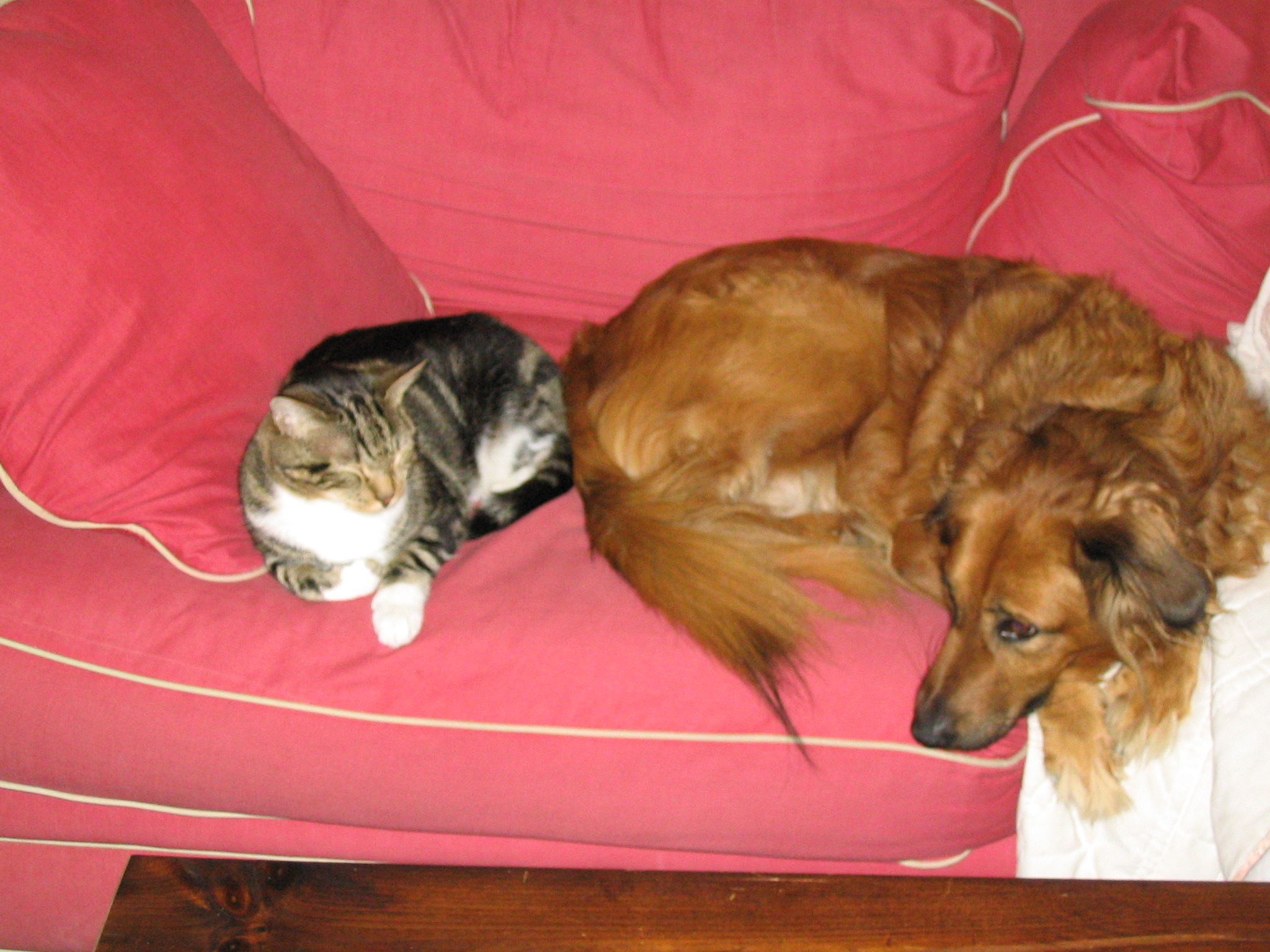
As someone who loves dogs there is a good chance that you are someone who loves all pets. Your family already includes a cuddly (or cantankerous) feline, and now you plan to open up your heart and home to an adoptable pooch. You’ve crossed your fingers and wished to the stars that your cat and dog will get along.
The relationship between your cat and dog doesn’t have to be based on luck, in fact advanced planning can help ensure a smooth transition for all family members, two- and four-legged.
In my experience, 85% of dog/cat pairings can be successful. There are probably some trainers out there who will give you an even higher percentage (note, I’m not a trainer, just someone with lots of dog and cat experience). I find, though, there are about 10% of dogs that have such a high prey drive that it isn’t worth the trouble to train them to live with a cat. The other 5% of cases that don’t work are due to pet parents not properly monitoring and molding the relationship.
So, how do you successfully introduce your new dog to your resident cat? Here are the steps I follow when bringing a new pup home:
1) First, understand the goal is for canine and feline to exist safely and peacefully. They do not need to be best friends – that is a bonus.
2) Before your pooch comes home set aside a room/section in the house that is designated cat-only. This is a place the cat can easily go for safety and quiet time. Also, it is helpful to have a few high areas around the house for the cat to escape (cat trees are helpful if your furniture is off limits). Be sure kitty can get to the litter box and food and water dishes without any canine harassment.
3) When you get home with your pup, walk him through the house on leash. See how he responds to the cat smells.
4) Next, still on leash, take him into the room where the cat is hanging out (not the cat-only room.) You may need a partner to carry the cat to you and the dog. Do not put the cat next to the dog or allow them get in striking distance of each other. Initially, you just want to see how they respond to one another visually. Does the dog lunge, growl, wag his tail when he sees the cat? Does the cat hold her ground or take off running? Try to gauge both pets first reaction – fear, excitement, aggression, disinterest?
5) During this initial introduction, start the training process. Once you gauge the first response from your pets, immediately ask the dog for his attention and give him a treat once he looks at you (you can use the treat to lure his attention). If the dog knows “sit”, ask for this behavior and give him another treat. The goal is for your pup to learn that seeing the cat equates to calm behavior and treats (eventually, you will wean out the treats).
6) If the dog pulls on the leash and tries to chase the cat, calmly but firmly tell him “No.” Ask for his attention (again, using a treat to get his focus on you). Only give treats when he gives you eye contact (you can slowly raise the treat up to your eye to get him to look at you). Repeat, and repeat, and repeat this training. Once your pup knows the “sit” command without the cat around, add this command to the training routine.
7) For the first few days keep the leash on the dog so you can quickly catch him if he starts to chase (the leash can just drag around behind him). If his chasing is relentless, you will need to keep cat and dog separated except for designated training times. During these times you need to keep your pup on the leash (or you could tether him to a heavy piece of furniture) and work on the attention and sit commands while the cat has freedom to roam. (don’t leave your dog tethered when you aren’t monitoring the training). You can also have the pets on opposite side of a reliable/sturdy baby gate for this training. Do not use the dog crate for this training. A dog crate should only be used for calm, quiet time and never for training or punishment.
8) Never leave cat and dog alone with access to each other when you aren’t present. Crate the dog (or leave him in a separate area), this includes night time when you are sleeping and can’t monitor their interaction.
9) With consistent training, you pup will quickly learn that chasing the cat is not welcome behavior. I find this usually takes about 5 – 7 days of regular training, however with some dogs it can take longer if they have a strong prey drive. A last word of caution – don’t get overly confident in the cat/dog relationship too quickly. Usually, you’ll make some positive progress for a few days and then may have a few setbacks. I keep a close eye on my cat and dog for 4 – 8 weeks before I begin to let my guard down.
When you adopt from The Barking Lot, we will bring the dog to your house to do a “cat test” with your potential new family member. We can quickly evaluate if the dog will be trainable and open to living with a cat, or if you might want to consider another pup that will be easier to train. Some other things to consider when selecting a dog that will be good with your cat:
- The smaller the dog the less worries you’ll have about your cat getting hurt in a scuffle. However, try to avoid small dogs that have a snappy, mouthy response to fear.
- Large, gentle giant breeds are typically marshmallows around kitties.
- A dog that is known to be good with small dogs will not necessarily be good with cats. Dogs can tell the difference between species.
- In my experience, herding dogs and herding dog mixes (Border Collies, Cattle Dogs, etc) tend to be good with cats. They are bred for herding (so they might give chase) but they aren’t necessarily trying to catch their target (although they might use their mouth for a gentle course correction). Plus, these breeds tend to be very smart and catch on quickly to training (note, if you are considering one of these breeds, they will need a lot of exercise). Companion dogs tend to be good with cats too (Dalmatians, “lap breeds”, etc)
- Terriers and sight hounds (e.g., Greyhounds) tend to have a high prey drive and are (again in my experience) hardest to train to live with a cat. That said, some of the gentlest dogs I’ve seen around cats are pittie mixes. So, often, it just comes down to the dog’s personality.
A few other notes to consider when blending your family with canines and felines:
- Keep the litter box in an area a dog can’t get to. Most dogs LOVE to eat cat poop. Not only is that a disgusting habit (who wants dog kisses after that!), but eating the litter along with it can be dangerous to their digestive system
- Keep the cat food where the dog can’t get to it (for instance, on a dresser), otherwise you’ll be wondering why you can’t seem to keep your pup’s weight down.
- If you have an aggressive cat that holds her ground and swats the dog, don’t let the dog fight back. Let the cat be dominant between the two…better to have a dog afraid of a cat than a dog that will hurt the cat.













This article is a HUGE help as this is exactly what my husband and I are looking to do in the near future! Thank you, thank you!
This was wonderful and insightful information. Thank you!
Good advice. Having been down this road with our recent adoptee, I can add that you may need to be very patient, and very consistent with a dog that has a strong prey instinct. We spent upwards of three months training our Staffordshire Terrier mix, but she now is entirely submissive to the cats – they can rub on her and sniff her face and she remains perfectly calm. Good luck!
Extremely helpful, our dog from the Barking Lot is a Wolf hybrid. So the vet says. He wants to kill my cats. I am working everyday with him. I will use your tips. Thank you